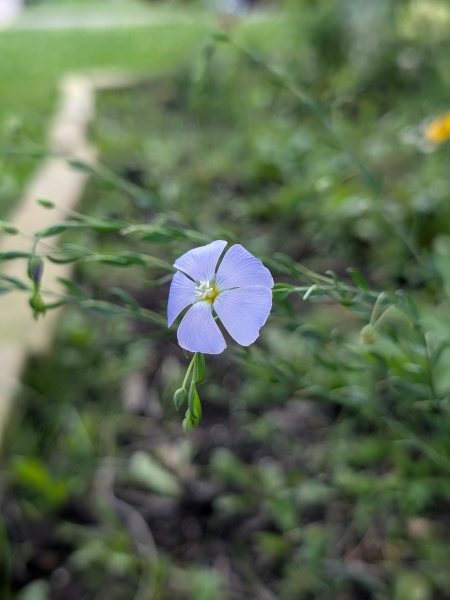 Known to be toxic - Toxic to grazing mammals if ingested.
Known to be toxic - Toxic to grazing mammals if ingested.

Source: Donna Bos
Linum lewisii
Lewis' Wild Blue Flax
Lin de Lewis
Synonyms
Lewis' blue flax
Lewis' flax
Lewis' wild flax
prairie flax
wild blue flax
No seeds available for this plant.
We currently accept seeds for this plant
Bloom Colour: Blue
Bloom Period: May - Jun
Max Height: 3.0 feet
Max Width: 2.0 feet
Light Condition:
 More than 6 hours of direct sun a day
More than 6 hours of direct sun a day
 More than 2 or 3 hours but less than 6 hours of direct sun a day
Soil conditions:
More than 2 or 3 hours but less than 6 hours of direct sun a day
Soil conditions:
 Tolerates medium soil condition
Tolerates medium soil condition
 More than 6 hours of direct sun a day
More than 6 hours of direct sun a day
 More than 2 or 3 hours but less than 6 hours of direct sun a day
More than 2 or 3 hours but less than 6 hours of direct sun a day
 Tolerates medium soil condition
Tolerates medium soil condition
Lifespan:
Perennial
plants that will that come back year after year
Gardener Experience:
 Suitable for beginner gardeners
Suitable for beginner gardeners
 Does not spread uncontrollably
Does not spread uncontrollably
 Easy to germinate
Easy to germinate
 Self-seeding
Self-seeding
 Suitable for beginner gardeners
Suitable for beginner gardeners
 Does not spread uncontrollably
Does not spread uncontrollably
 Easy to germinate
Easy to germinate
 Self-seeding
Self-seeding
Landscape Uses:
 Suitable for rock gardens
Suitable for rock gardens
 Suitable for container garden
Suitable for container garden
 Suitable for school gardens
Suitable for school gardens
 Suitable for rock gardens
Suitable for rock gardens
 Suitable for container garden
Suitable for container garden
 Suitable for school gardens
Suitable for school gardens
Ecological Benefits:
No ecological benefits information available.
Tolerates:
 Tolerates transplantation
Tolerates transplantation
 Tolerates transplantation
Tolerates transplantation
Special Features and Considerations:
 This plant is endangered
This plant is endangered
 This plant is endangered
This plant is endangered
Plant Location
Distribution according to VASCAN

Ephemeral
Native
Introduced
Excluded
Extirpated
Doubtful
Absent
Thrives in Ecozones
- Taiga Plains
- Taiga Shield
- Boreal Plains
- Montane Cordillera
- Prairies
- Boreal Shield
- Pacific Maritime
Ecological Benefits
Butterflies Supported by Linum lewisii
No butterfly data available for this plant.
Specialized Bees Supported by Linum lewisii
No bee data available for this plant.
Plants that grow in similar conditions, that bloom at the same time.
Complementary Plants
- Allium cernuum
Nodding Onion
Ail penché - Coreopsis lanceolata
Lance-leaved Coreopsis
Coréopsis lancéolé - Erigeron strigosus
Rough Fleabane
Vergerette rude - Monarda didyma
Scarlet Beebalm
Monarde écarlate - Verbena stricta
Hoary Vervain
Verveine veloutée
Substitute For Non-Native Plants
- Linum usitatissimum (Common Flax)
- Myosotis sylvatica (Forget-me-not)
Sowing Information
Download Seed Envelope Labels (PDF)
- Sowing depth: Sow just below surface
- Sow anytime
- Stratification duration: 0 days
- Self-seeding
Harvesting and Seed Sharing
- Harvest start month: July
- Harvesting indicator:
- Pods are slightly open and seeds inside are dark
- Harvesting:
- Cut stem (including pods), let air dry in paper bag, then shake seeds off after a few days
- Seed viability test:
- No test needed before donating
- Packaging measure: 1 rounded 1/8 teaspoon
- Seed storage:
- Air dry in paper bag or open container, for a few days until crisp
- Shake seeds to move them once in a while to prevent molding
- Cultivar: Yes, do not donate unless you know source, and there are no known cultivars in your garden or at proximity
- Harvesting video: Watch here
Toxicity Notes
Toxic to grazing mammals if ingested.


 Canadensis
Canadensis
